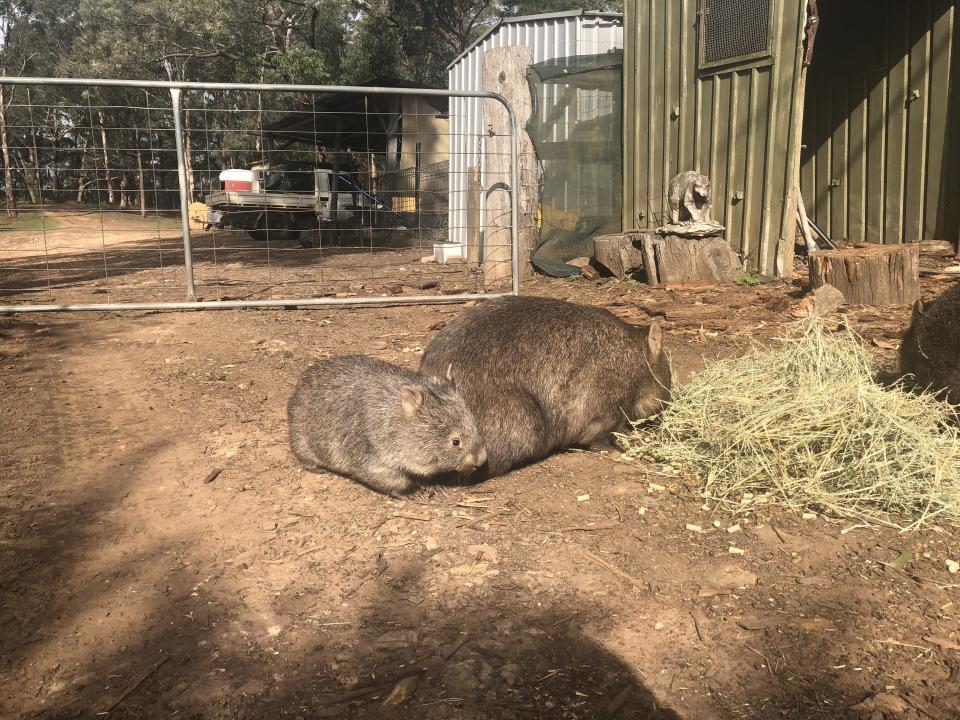'That haunted look': Drought-hit wildlife carers make desperate plea as animals starve
As paddocks turn to dust and forests die, Aussie wildlife volunteers in drought stricken regions are desperately crowdfunding to help feed starving animals.
Footage shared by Queenslander Jenny Hillman shows denuded fields with wallabies and birds desperate for nourishment in Stanthorpe, 200km southwest of Brisbane.
“It’s fairy horrendous,” she told Yahoo News Australia.
“The wallabies are looking more and more skinny.
“They’ve got that haunted, big-eyed look.
“And most of the females have got joeys.

South to Wollombi, in the NSW Hunter Valley, the situation at Cedar Creek Wombat Hospital is just as desperate.
Registered vet nurse Roz Holmes told Yahoo News Australia that there is no grass left on the 200 acre property where she has raised wombats for 14 years.
“Our yard is just complete dirt,” she said.
“Down in our gully it was when we bought it like a rainforest with creeks running through it - now all of it is dead.
A lot of the big trees are starting to die off too, which is pretty sad.”
‘Upsetting’: Wild wombats return to their carers
Wombats that Ms Holmes raised during her years at the property are now returning to her in search of food and water and she recently raised much needed funds through crowdfunding that she hopes will last through the summer.
“Being a carer you want to rain your animals to be wild and survive on your own.
“It’s a bit upsetting to know that all your hard work training them to be wild and now you’ve got to feed them again.
“But I’m not going to let them suffer either.”
Ms Holmes said carers are having to think long and hard before they raise baby animals, as the drought means there is often nowhere for it to go once it reaches adulthood.


‘Every spare dollar’ spent on wildlife feed
With predictions that the Stanthorpe area, would run out of water by Christmas due to extreme weather, the Queensland government has agreed to buy water for the town, but rural properties not connected to water mains remain parched.
Ms Hillman puts out 10 containers of water for native animals, but the cost of supporting wild populations has become “exhausting and expensive”.
As local fields have dried up, feed often needs to be carted in from Victoria and the price of hay has skyrocketed from $80 to $250 a bale.
The Queenslander has just begun a plea to raise $1,000 through crowdfunding site GoFundMe, hoping to help buy four large hay bales to help.
“I spend every spare dollar I get on animal feed but it's just not enough,” she wrote online.
“There is no feed left out there for the native animals, just dry empty land and no relief in sight.
“I would be forever grateful for your help.’


As farmers and wildlife compete for resources, Ms Holmes is increasingly hearing stories from carers around NSW of wombats being illegally shot.
As wildlife wanders across roads in search of the remaining tufts of grass, carers are also reporting increases in animal road deaths.
'Shame on you': Senator's disturbing roadkill posts revealed
Man urges Aussies to take on 'horrendous' task to reduce roadkill
Wildlife rescuers' plea to motorists if they accidentally hit wildlife on road
“I think it’s pretty hard on all of us now - I’ve got a lot of carer friends that are really struggling at the moment,” she said.
“All we can do is just hope it’s going to rain soon.
“But even if we get rain like it did a few weeks ago, it’s going to take forever for the grass to grow because the animals are that hungry they’re going to eat whatever comes up.”
The author, Michael Dahlstrom, is a registered wildlife carer in NSW.
Do you have a story tip? Email: newsroomau@yahoonews.com.
You can also follow us on Facebook and Twitter, download the Yahoo News app from the App Store or Google Play and stay up to date with the latest news with Yahoo’s daily newsletter. Sign up here.


